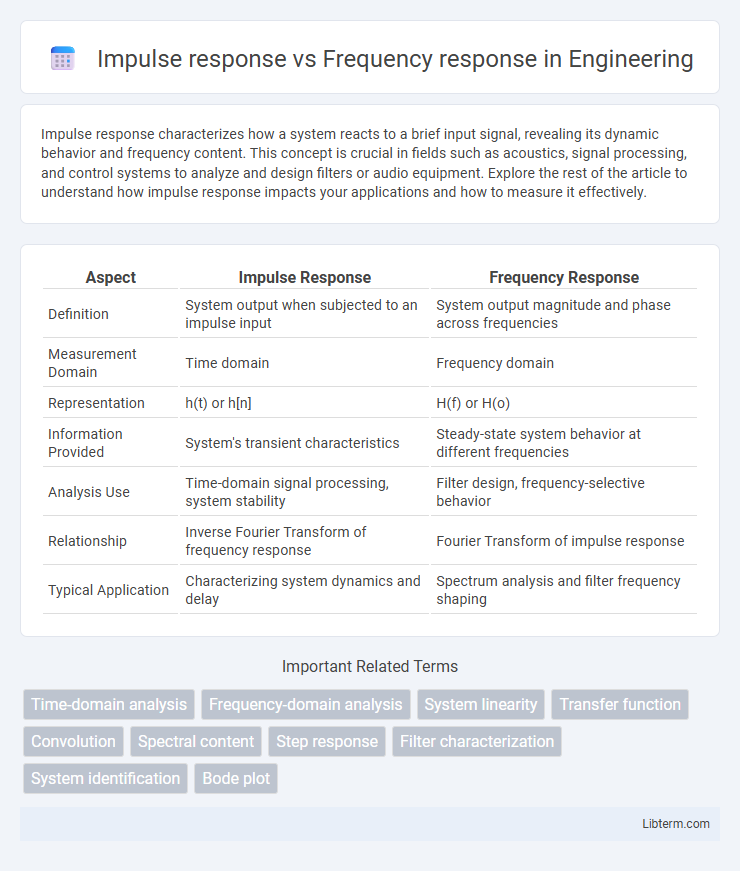Impulse response characterizes how a system reacts to a brief input signal, revealing its dynamic behavior and frequency content. This concept is crucial in fields such as acoustics, signal processing, and control systems to analyze and design filters or audio equipment. Explore the rest of the article to understand how impulse response impacts your applications and how to measure it effectively.
Table of Comparison
| Aspect | Impulse Response | Frequency Response |
|---|---|---|
| Definition | System output when subjected to an impulse input | System output magnitude and phase across frequencies |
| Measurement Domain | Time domain | Frequency domain |
| Representation | h(t) or h[n] | H(f) or H(o) |
| Information Provided | System's transient characteristics | Steady-state system behavior at different frequencies |
| Analysis Use | Time-domain signal processing, system stability | Filter design, frequency-selective behavior |
| Relationship | Inverse Fourier Transform of frequency response | Fourier Transform of impulse response |
| Typical Application | Characterizing system dynamics and delay | Spectrum analysis and filter frequency shaping |
Introduction to Impulse and Frequency Response
Impulse response represents a system's output when subjected to a very short input signal, capturing its complete time-domain characteristics. Frequency response describes how a system reacts to different frequencies, showcasing magnitude and phase shifts across the spectrum. Both responses are fundamental in understanding and analyzing linear time-invariant (LTI) systems in signal processing and control engineering.
Defining Impulse Response
Impulse response is a fundamental concept in signal processing, representing the output of a system when presented with a brief input signal or an impulse. It fully characterizes a system's behavior in the time domain, capturing how the system reacts to every possible input over time. Analyzing the impulse response allows the derivation of the frequency response, which describes the system's behavior across different frequencies.
Understanding Frequency Response
Frequency response characterizes how a system, such as an audio device or filter, alters input signals across different frequencies, revealing gain or attenuation levels at each frequency point. It is derived from the system's impulse response through the Fourier transform, converting time-domain data into the frequency domain for analysis. Understanding frequency response is crucial for optimizing system performance, ensuring accurate signal reproduction, and minimizing distortion in applications like audio engineering and telecommunications.
Key Differences Between Impulse and Frequency Response
Impulse response measures a system's output in the time domain to a brief input signal, revealing how it reacts over time, while frequency response characterizes the system's steady-state behavior across frequencies, showing amplitude and phase shifts. Impulse response captures transient dynamics and is foundational for deriving frequency response via Fourier Transform. Frequency response directly illustrates how different frequency components are attenuated or amplified, essential for understanding filtering and signal processing properties.
Importance in Signal Processing
Impulse response characterizes a system's output in the time domain when subjected to a brief input signal, revealing its temporal behavior and stability. Frequency response describes how the system amplifies or attenuates signals at different frequencies, providing critical insight into filtering and resonance characteristics. Understanding both impulse and frequency responses is essential for designing and analyzing filters, communication systems, and control systems in signal processing.
Mathematical Representation
Impulse response is mathematically represented as h(t), describing a system's output when subjected to a Dirac delta function input, capturing the system's time-domain characteristics. Frequency response H(f) is the Fourier transform of the impulse response h(t), expressed as H(f) = h(t)e^{-j2pft} dt, illustrating the system's behavior across different frequencies. Analyzing these representations enables the characterization of linear time-invariant (LTI) systems in both time and frequency domains.
Real-World Applications
Impulse response captures how a system reacts to a brief input signal, enabling precise characterization of acoustic environments, such as room reverberation analysis in architectural acoustics. Frequency response reveals a system's output amplitude and phase across frequency bands, crucial for designing and tuning audio equipment like equalizers and microphones. Both responses provide complementary insights for audio engineers optimizing sound quality in live venues, recording studios, and telecommunication systems.
Measurement Techniques
Impulse response measurement involves capturing a system's reaction to a brief, broadband input signal, often using techniques like maximum length sequences (MLS) or sine sweeps to achieve high signal-to-noise ratios. Frequency response measurement typically employs swept sine tones or multi-tone signals to analyze amplitude and phase characteristics across a defined frequency range with precise resolution. Both methods require careful calibration and windowing to minimize artifacts, ensuring accurate characterization of acoustical or electronic systems.
Advantages and Limitations
Impulse response reveals a system's complete time-domain behavior, enabling precise analysis of transient characteristics and system dynamics, which is essential for designing and troubleshooting complex filters and control systems. Frequency response provides direct insight into amplitude and phase characteristics across frequencies, simplifying the evaluation of steady-state performance and filter design efficiency. However, impulse response data can be voluminous and sensitive to noise, making interpretation challenging, while frequency response may overlook important time-domain details such as transient effects and nonlinear behaviors.
Choosing the Right Approach for Your Needs
Choosing between impulse response and frequency response depends on your specific audio analysis goals. Impulse response captures a system's time-domain characteristics, revealing how it reacts to a brief signal, which is essential for assessing reverberation and echo patterns. Frequency response provides a steady-state view of system behavior across frequencies, making it ideal for equalization and identifying frequency-dependent distortions.
Impulse response Infographic

 libterm.com
libterm.com